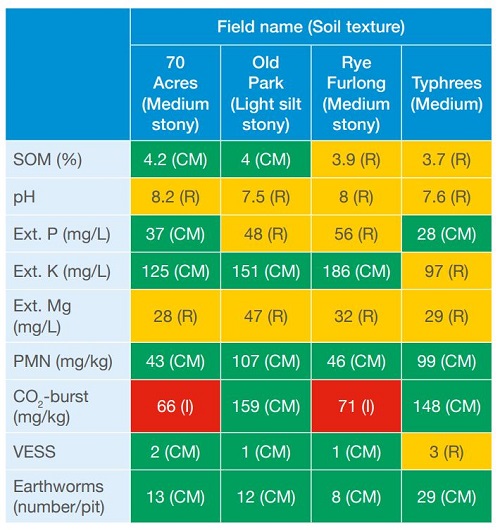Great news for GREATsoils: AHDB issues Soil Health Scorecard guidance
Thursday, 13 October 2022
Soil health has been broken down into measurable parts to help farmers optimise crop and grassland productivity. Dr Amanda Bennett, AHDB Senior Environment Manager, explains.
Soils are the foundation of agriculture, supporting the production of food, feed, and fibre. They also provide a range of ‘ecosystem services’, helping to regulate climate and water, sequester carbon, and cycle nutrients.
It is important that soils are managed appropriately to deliver these functions. Yet, their inherent properties (soil type and geological history) and site-specific management mean each field’s soil has its own unique fingerprint.
Cultivations, drainage, inputs, rotation, and cropping sequence all impact a soil’s physical, chemical, and biological make-up. As a result, the unique context of your soils means that what works in one field may fail to work the same way in another. However, there is one universal tip that applies in any situation: to optimise soil health, you need to measure it first.
Soil health indicators
The levy-funded Soil Biology and Soil Health Partnership developed and validated a set of practical indicators for the routine measurement and monitoring of soil health:
- Visual evaluation of soil structure (VESS)
- pH
- Extractable nutrients (P, K, Mg)
- Soil organic matter
- Earthworms
- Measures of microbial activity*
The researchers worked with farmers, industry, and scientists, to develop a robust, simple, and visual framework – the Soil Health Scorecard – to group these soil health indicators.
Although putting the indicators in one place was a great step, it is the inclusion of benchmark values that offers a potential revelation for soil management.
For each indicator, the partnership identified ‘typical’ benchmark values (expected ranges for UK soil types and climate regions).
The scorecard exploits these values to grade the results of site-specific soil analyses using a traffic-light code:
- Green (monitor): Typical or optimum result, with low risk of sub-optimal soil conditions (continue to monitor on a rotational basis)
- Amber (review): Moderate risk of sub-optimal soil conditions (further examination, such as more frequent or detailed sampling, may be needed)
- Red (investigate): Potential risk of sub-optimal soil conditions (more immediate management intervention may be required)
Soil Health Scorecard example
 AHDB
AHDB
- Green = Continue rotational monitoring (CM)
- Amber = Review (R)
- Red = Investigate (I)
For the story behind this scorecard, see page 20 of our Arable Review.
Soil health guidance
The Soil Health Scorecard is a simple way to generate data on a variety of soil health metrics.
However, for the approach to be effective, it is essential to follow sound soil sampling and analysis approaches.
To help, we’ve issued guidance that covers in-field soil sampling and record-making.
The AHDB Cereals & Oilseeds YouTube account also features a fascinating ‘how-to’ field-demonstration video, delivered by NIAB’s Elizabeth Stockdale (partnership lead scientist).
The guidance document also details the benchmark values for the physical, chemical, and biological soil health indicators (for crops and grassland). Due to variations in the analytical methods used across GB regions, guidance for England and Wales, and Scotland is available.
Importantly, the guidance highlights management recommendations for the current traffic-light soil condition – to help you maintain or improve your soils.
This structured way to evaluate soils is also useful if you want to assess changes to soil management. For example, if you plan to change your cultivation technique, simply complete the Soil Health Scorecard first. Subsequent analyses will provide valuable insight into how soil condition has been affected.
The Soil Health Scorecard does not tell you what to do, per se. It focuses attention on the aspects of soil health that warrant closer attention, allowing you to make more informed decisions to benefit your unique farm business.
Further information
Coming soon: An Excel version of the Soil Health Scorecard.
Access the full range of soil management resources (GREATsoils)
Visit the Soil Biology and Soil Health Partnership page
Attend a Monitor Farm meeting (soil health is often featured)
*Respiration (CO2–C burst) and potentially mineralisable nitrogen are the measures of microbial activity considered in the Soil Health Scorecard.
Topics:
Sectors:
Tags:





.jpg)